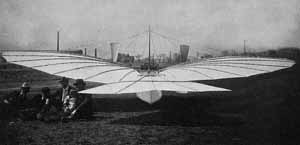

|

Published Articles
|

Other Research
|

Affidavits
|
| “Two years, four months and three days before the successful flights
of the Wright brothers at Kitty Hawk, a birdlike monoplane took
to the air at early dawn on August 14, 1901, near Bridgeport,
Connecticut, carrying its inventor and builder, Gustave Whitehead,
a distance of approximately a half mile. So reported the Bridgeport
Herald, the New York Herald and the Boston Transcript.” Stella Randolph, The Lost Flights of Gustave Whitehead |
 wo Years Before the Wrights
wo Years Before the Wrights

|
 |
 The August, 1901 flight is the first of Whitehead’s flights that
has been documented with any success. Reports of his 1899 flight
are confused and conflicting at best, with only one testifiable
witness found. However, the August flight was been well noted,
not only by neighbors and assistants to this pioneering move,
but also by some of the major newspapers of the time. On that
historic day, at least four flights were reported to be made,
the first before daybreak after a long night of attempting to
get the “Bird” to fly. Three more flights were made in the afternoon
of the same day, the longest of these was said to have covered
a distance of one and a half miles at about 200 feet off the ground.
These flights were made by the plane that Whitehead referred to
as Number 21. The August, 1901 flight is the first of Whitehead’s flights that
has been documented with any success. Reports of his 1899 flight
are confused and conflicting at best, with only one testifiable
witness found. However, the August flight was been well noted,
not only by neighbors and assistants to this pioneering move,
but also by some of the major newspapers of the time. On that
historic day, at least four flights were reported to be made,
the first before daybreak after a long night of attempting to
get the “Bird” to fly. Three more flights were made in the afternoon
of the same day, the longest of these was said to have covered
a distance of one and a half miles at about 200 feet off the ground.
These flights were made by the plane that Whitehead referred to
as Number 21.
There is more evidence to show that on January 17, 1902, one year
and eleven months before Kitty Hawk - two flights were made by
Whitehead in a monoplane powered with a kerosene burning engine.
Both of these were conducted at Lordship Manor, one lasting a
distance of two miles and the other a distance of seven miles
over Long Island Sound. These flights were made by the plane that
Whitehead referred to as Number 22.
Unfortunately, because Whitehead did not make accurate records
of his flight attempts and successes, the distances and heights
from the ground are only estimates by witnesses who were present
at the flights
The Wright Brothers first flights were nowhere near as impressive.
The longest flight of three runs made at Kitty Hawk on December
17, 1903 was 59 seconds for 852 feet. There is also evidence in the form of an affidavit that connects
the Wright brothers success to information provided them by Gustave
Whitehead.
|
|
 |
  |


![]() wo Years Before the Wrights
wo Years Before the Wrights![]()
![]()
![]() The August, 1901 flight is the first of Whitehead’s flights that
has been documented with any success. Reports of his 1899 flight
are confused and conflicting at best, with only one testifiable
witness found. However, the August flight was been well noted,
not only by neighbors and assistants to this pioneering move,
but also by some of the major newspapers of the time. On that
historic day, at least four flights were reported to be made,
the first before daybreak after a long night of attempting to
get the “Bird” to fly. Three more flights were made in the afternoon
of the same day, the longest of these was said to have covered
a distance of one and a half miles at about 200 feet off the ground.
These flights were made by the plane that Whitehead referred to
as Number 21.
The August, 1901 flight is the first of Whitehead’s flights that
has been documented with any success. Reports of his 1899 flight
are confused and conflicting at best, with only one testifiable
witness found. However, the August flight was been well noted,
not only by neighbors and assistants to this pioneering move,
but also by some of the major newspapers of the time. On that
historic day, at least four flights were reported to be made,
the first before daybreak after a long night of attempting to
get the “Bird” to fly. Three more flights were made in the afternoon
of the same day, the longest of these was said to have covered
a distance of one and a half miles at about 200 feet off the ground.
These flights were made by the plane that Whitehead referred to
as Number 21.
![]()
![]()
![]()
![]()
![]()